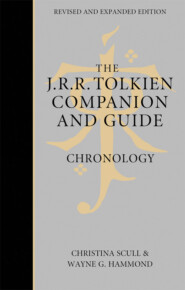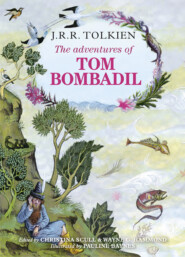По всем вопросам обращайтесь на: info@litportal.ru
(©) 2003-2024.
✖
The J. R. R. Tolkien Companion and Guide: Volume 2: Reader’s Guide PART 1
Настройки чтения
Размер шрифта
Высота строк
Поля
In Christopher Tolkien’s words, The Book of Lost Tales was ‘the first substantial work of imaginative literature by J.R.R. Tolkien, and the first emergence in narrative of the Valar, of the Children of Ilúvatar, Elves and Men, of the Dwarves and the Orcs, and of the lands in which their history is set, Valinor beyond the western ocean, and Middle-earth, the “Great Lands” between the seas of east and west’ (The Book of Lost Tales, Part One, p. 1). It was also the first expression of the *‘Silmarillion’ mythology in prose. Poems, drawings, and references in letters from the years preceding its writing, however, show that many of its elements had already been developing in Tolkien’s thoughts. Among the more significant of these poems were The Voyage of Éarendel the Evening Star (*Éalá Éarendel Englo Beorhtast, September 1914); *The City of the Gods (earlier Kôr, April 1915); *The Happy Mariners (July 1915); and Kortirion among the Trees (November 1915, later *The Trees of Kortirion). In 1915 Tolkien also made several watercolours which suggest that he was visualizing particular places: Tanaqui (Artist and Illustrator, fig. 43) almost certainly depicts Kôr. Most significant are a watercolour dated 10 May 1915, *The Shores of Faery (Artist and Illustrator, fig. 44), with an accompanying poem, each showing or referring to Kôr and to the Sun and Moon forming from the Two Trees.
Tolkien may have begun to write The Book of Lost Tales while still in the First Southern General Hospital (*Birmingham and environs) in November 1916, or during his sick leave in *Great Haywood (Staffordshire) from mid-December that year. There is no clear evidence for this, nor for whether The Cottage of Lost Play or The Fall of Gondolin came first among the tales. Tolkien several times referred to The Fall of Gondolin as the first to be written; but he may not have considered The Cottage of Lost Play a tale. It introduces the framework of the tales, and Eriol who hears them; and although Eriol survived as a transmitter of documents and traditions in later texts of the mythology, the Cottage of Lost Play itself did not appear again after The Book of Lost Tales. This interpretation might seem to be strengthened by Tolkien’s description of The Fall of Gondolin as ‘the first real story of this imaginary world’ in a letter to W.H. Auden (7 June 1955, Letters, p. 215); but a note by Tolkien, probably from 1919, which reads ‘Link between Cottage of Lost Play and (Tale 2) Music of Ainur’ (The Book of Lost Tales, Part One, p. 45) suggests that at that early date he did consider the former a ‘tale’ (although The Music of the Ainur was certainly not the second tale written, it was the first told to Eriol).
Whenever he began it, Tolkien completed the first pencil version of The Cottage of Lost Play on loose sheets by early February 1917, when *Edith Tolkien wrote on the cover of the exercise book in which she made a fair copy ‘her initials, E.M.T., and a date, Feb. 12th 1917’ (The Book of Lost Tales, Part One, p. 13) – either the date she began the copy, or the date she finished it. Either then or at some later date, Tolkien made a few emendations. As early as April 1915 he had written a poem, You & Me and the Cottage of Lost Play (*The Little House of Lost Play: Mar Vanwa Tyaliéva), in which children meet and play in their sleep in the gardens of a cottage; but it cannot be known if, at that time, he foresaw the part the Cottage would play in The Book of Lost Tales. The main theme of the poem concerns two children, presumably Edith and Tolkien himself, meeting and playing together in dreams in the garden and surrounding area.
With no contemporary evidence to date the writing of the first (pencil) version of The Fall of Gondolin in two exercise books, one must rely on statements made by Tolkien decades later. He dated the writing of The Fall of Gondolin to the end of 1916 or to 1917, and sometimes mentioned having written it only while on sick leave, and sometimes while in hospital and on sick leave. Its writing could equally precede or follow The Cottage of Lost Play, or he may have worked on both at once. One factor in suggesting that it came second is that, with The Cottage of Lost Play completed by early February 1917, and the next tale not begun until June 1917 at the earliest, the writing (or most of the writing) of The Fall of Gondolin would fit well into the intervening period.
Tolkien substantially overwrote the pencil version of The Fall of Gondolin in ink, without erasing the pencilled text though in places striking it through. Christopher Tolkien has described this revision as ‘by no means a complete recasting (still less a re-imagining)’ (The Book of Lost Tales, Part Two, p. 146). From this emended state Edith Tolkien wrote out a fair copy, which Christopher Tolkien in *Unfinished Tales (1980) believed was done ‘apparently in 1917’ (p. 5). By the time he came to edit The Book of Lost Tales, Part Two, however, he came to think it ‘improbable’ that the revision and fair copy were made in 1917, and associated them more closely to his father’s preparation of The Fall of Gondolin for public reading in spring 1920 (Part Two, p. 146). This later judgement seems to be supported by the evidence presented in the note on The Fall of Gondolin given below, item 23 in the sequence of texts.
The story after The Fall of Gondolin, The Tale of Tinúviel, was evidently not foreseen, but inspired by a contemporary event in Tolkien’s own life, when his wife Edith danced for him in a woodland glade near Roos (*Yorkshire). Tolkien wrote about this event several times. In 1963, for instance, in a letter to Nancy Smith, he said: ‘The kernel of the mythology, the matter of Lúthien Tinúviel and Beren, arose from a small woodland glade filled with “hemlocks” (or other white umbellifers) near Roos on the Holderness peninsula – to which I occasionally went when free from regimental duties while in the Humber Garrison in 1917’ (Letters, p. 221, ‘1918’ corrected by the present authors to ‘1917’; see *Tolkien on Tolkien). And on 16 July 1964 he told Christopher Bretherton that he wrote The Fall of Gondolin in 1917, and later in the same year ‘the original version of the “Tale of Lúthien Tinúviel and Beren” … founded on a small wood with a great undergrowth of “hemlock” … near Roos in Holderness …’ (Letters, p. 345).
Internal evidence in the tale and in later retellings suggest that the visit to the wood took place in early summer, probably in late May or early June. The flowering season for hemlocks and other umbellifers in England at its widest range is May to September; Tolkien also mentions chestnut trees in flower and white moths fluttering: chestnut trees usually flower in late May or early June, and moths are unlikely to be active outside the warmer months. In The Tale of Tinúviel Tolkien actually states that Beren first saw Tinúviel in ‘June’. As for external evidence, Tolkien was certainly with the Humber Garrison between mid-April and mid-August 1917, except for a period at a signalling school. In a note to a letter to Christopher Tolkien of 11 July 1972, he said that ‘the earliest form of the legend’ was ‘written in hospital’, which would place all or part of the actual writing of the first pencil version to mid-August–October 1917 (Letters
Вы ознакомились с фрагментом книги.
Приобретайте полный текст книги у нашего партнера:
Приобретайте полный текст книги у нашего партнера:








